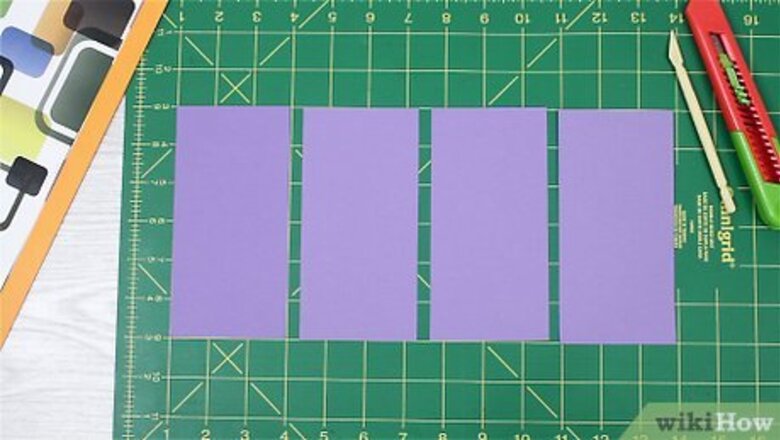
views
Assembling a Card with Glue
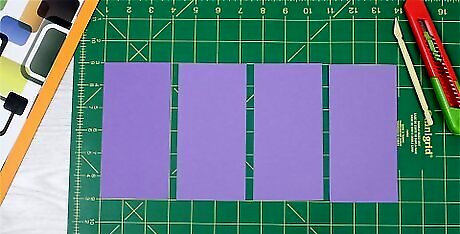
Cut 4 matching rectangles out of cardstock for the card base. Each rectangle should measure 6 in (15 cm) long by 3 in (7.6 cm) wide. Use a ruler and pencil to mark out the 4 rectangles onto a stiff piece of cardstock. Cut along the edges with a paper cutter to get perfectly straight lines. Opt for a medium to heavy weight cardstock. Choose a neutral color such as white or cream, or use something more colorful for the base. Either way, cut all 4 pieces out of the same cardstock to enhance the never-ending illusion.
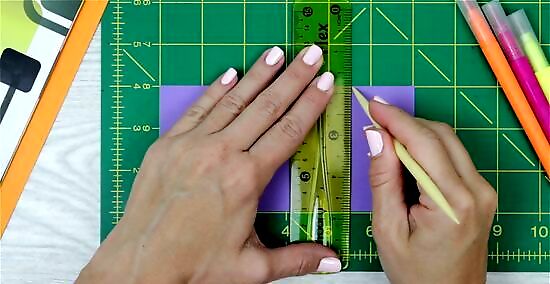
Score all 4 rectangles 1 ⁄2 in (3.8 cm) in from the short edges. Working with 1 rectangle at a time, lay the cardstock piece on a scoring board. Position the short end parallel to the scoring channels. Use a bone folder or another scoring tool to create a straight score line. Do this once along the left side, 1 ⁄2 in (3.8 cm) in from the short edge. Score another line on the right side, 1 ⁄2 in (3.8 cm) away from the short edge. Repeat this process to score all 4 card base pieces. Once you’re finished, each rectangle will be divided into thirds, with a square in the center and narrow rectangles on either side. If you don’t have a scoring board, use a ruler to guide your scoring marks. A bone folder is the best tool for creating a crisp indentation that will fold easily. If you don’t have one, use the blunt side of a butter knife to score the cardstock.
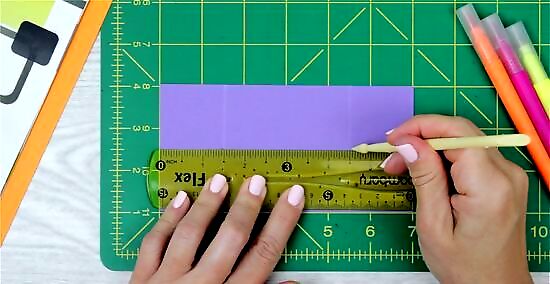
Create perpendicular score lines on the left and right sides of each piece. Rotate a piece of cardstock 90 degrees on the scoring board, so that its long end lines up with the scoring channels. Use the bone fold to score down the center of the cardstock, from the top edge until you reach the previous score line. Repeat this process for the other side of the rectangle. Repeat this process for all 4 pieces. On each piece of cardstock, you should now have a perpendicular score mark placed 1 ⁄2 in (3.8 cm) in from either side, which stops when it touches the crosswise score mark. After the scoring is complete, each rectangle will be divided into a large central square with 2 small squares stacked together on the left and right sides.
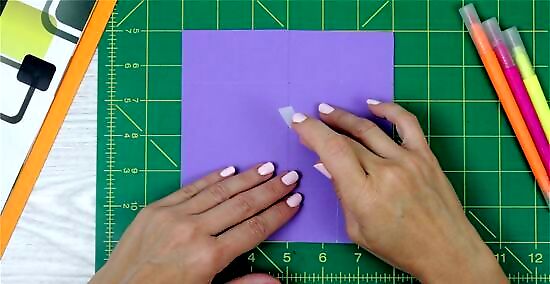
Place 2 pieces of scored cardstock side by side to form a large square. Take 2 pieces of scored cardstock and lay them down next to each other on your work surface. Arrange them lengthwise, with the long edges running vertically, so they create a large square. Feel free to add a very small piece of low tack artists’ tape in the center to prevent the 2 pieces from moving.
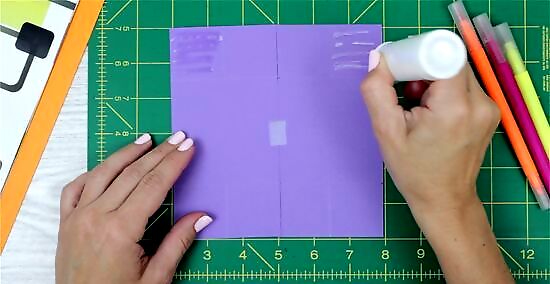
Apply glue to the top left and top right corners of the large square. Spread a small amount of white liquid craft glue onto the top 2 corners of the large square you’ve formed with the first 2 pieces of cardstock. Keep the glue inside the score lines. Liquid glue is preferable to a glue stick or double-sided tape since it will allow you to adjust the pieces of cardstock until they’re perfectly aligned.
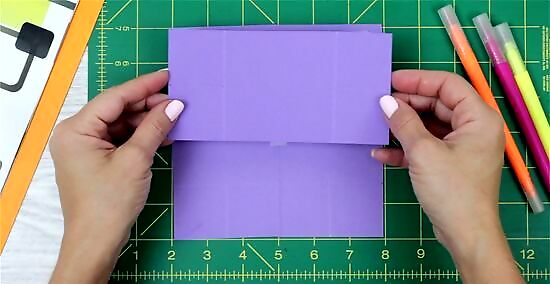
Affix the third piece of cardstock onto the top half of the large square. Lay the third cardstock rectangle onto the top half of the large square. Keep its long end perpendicular to the long ends of the other 2 pieces, and make sure its corners are positioned on top of the glued corners. Align the corners and edges up with the other 2 pieces, then press down to bind the cardstock pieces together. Now the top half of the large square will have 2 layers of cardstock.
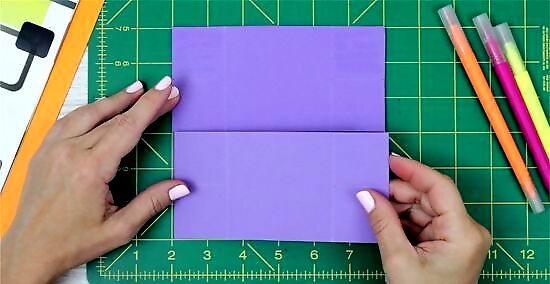
Glue the fourth piece of cardstock onto the bottom half of the large square. Apply white craft glue to the lower left and lower right corners of the large square, keeping the glue within the score lines. Take the fourth cardstock rectangle and align its long edge with the bottom half of the large square. The fourth piece of cardstock should meet the third piece in the middle. Their long edges will be running perpendicular to long edges of the first 2 pieces of cardstock. Make sure the pieces don’t overlap where they meet along the long edges. They should just touch. Any overlapping will interfere with the card’s unfolding patterns.
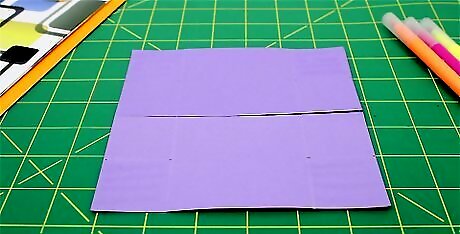
Allow the glue to dry completely. Once you’re sure that the alignment is correct, press down on all 4 corners to make sure the layers of paper adhere to each other. Wait up to 10 minutes or until the glue has set before unfolding the card.
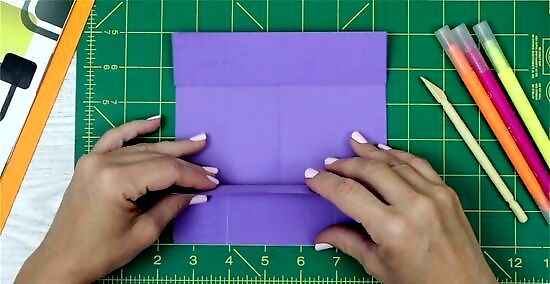
Open the card flaps from the middle and fold them along the score lines. After the glue has dried, gently open up the card. Lift the top flap up and the bottom flap down, then press back both flaps along the score lines you created earlier. Press along the fold line with the side of a bone folder or your fingernail to create a crease. The top cardstock pieces will fold back on themselves and the under layer will be revealed. Now your large square will be divided into 3 parts horizontally, with a narrower top and bottom band and a thicker rectangle in the middle. If you added a piece of tape to hold the cardstock together, remove it once it’s exposed.
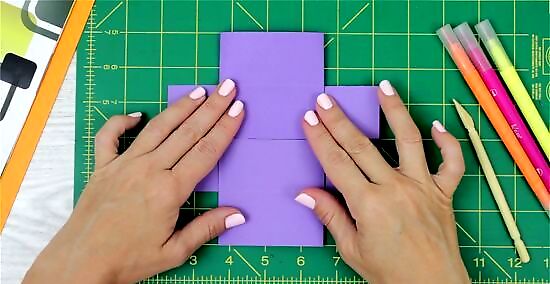
Open and fold the left and right flaps along the score lines. In a similar fashion to how you opened the top and bottom flaps, lift up the left and right flaps from the middle so that the cardstock folds back on itself. Create a crease along the folds on either side, using a bone folder or your fingernail. Now the card will be a plus-shape.
Making a Card without Glue
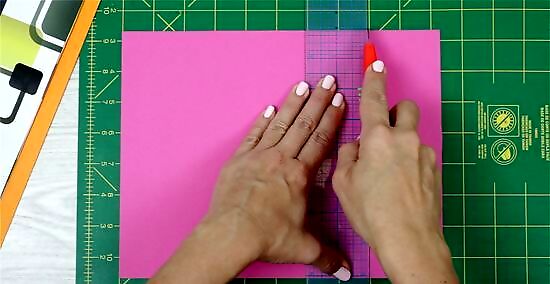
Cut out an 8 in (20 cm) square piece of cardstock. Mark out the dimensions with a pencil and ruler to draw onto a stiff sheet of cardstock. Cut it out with paper scissors, or use a paper cutter to get the straightest possible lines. A medium to heavyweight cardstock will work best for this project. These dimensions will result in a 4 in (10 cm) by 4 in (10 cm) square card. Feel free to use a larger or smaller piece to start with if you want to scale the card up or down.
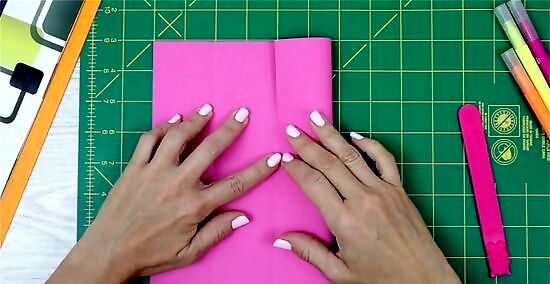
Fold the cardstock square into lengthwise quarters. First, fold the square piece of cardstock in half lengthwise. Create a crease along the fold line with a bone folder or your fingernail. Open it back up and fold in the left and right sides to meet the central fold line. Crease these folds as well. You’ll now have 3 parallel creases dividing the paper into 4 narrow rectangles. Don’t fold the cardstock in half lengthwise and then in half crosswise. This won’t give you the right shape for the crease lines.
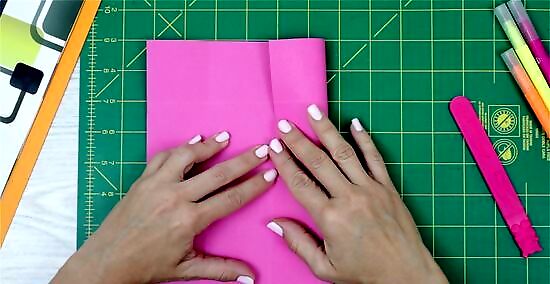
Fold the cardstock into crosswise quarters to make 16 small squares. Open up the folded piece of cardstock. Then fold in half crosswise, intersecting the existing crease lines. Open it back up and fold in the top and bottom sides to meet the central fold line you just created. These folds will also intersect the earlier crease lines. Be sure to crease these new folds with a bone folder or your fingernail. Now the square piece of cardstock will be divided into 16 small square sections, each measuring 2 in (5.1 cm) by 2 in (5.1 cm).
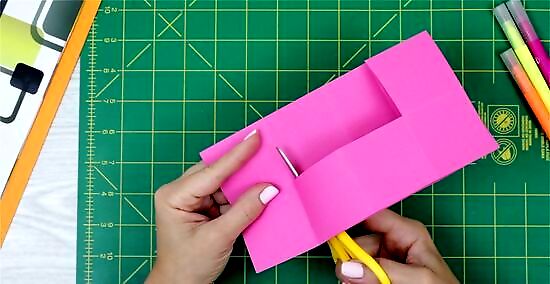
Cut out the 4 central squares. You’ll notice the cardstock now has a border of 12 squares surrounding a middle cluster of 4 squares. Remove these 4 squares by folding the cardstock in half and using paper scissors to cut along the fold, following the crease marks outlining these 4 squares. Unfold the card and you’ll see that the piece of cardstock is now a border of 12 squares with an opening in the middle.
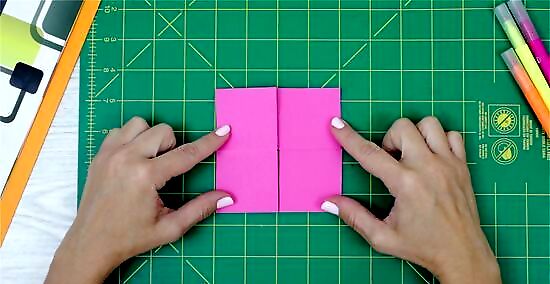
Fold all 4 sides of the border towards the middle to create a smaller square. Start by folding the bottom side of the square up. Line up the edge of this piece with the middle crease line. Then fold the right side inwards, followed by the top side and finally the left side. Once all of the edges have been turned inwards, you'll have a 4 in (10 cm) by 4 in (10 cm) square, with 2 squares on each side.
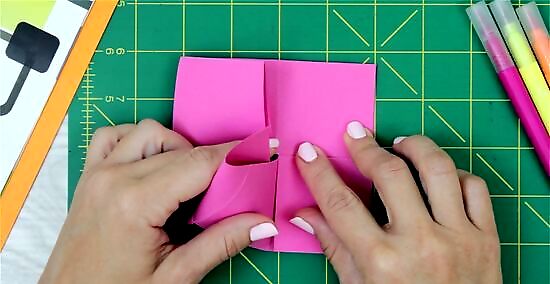
Tuck the corner square on the left side under the corner square on the bottom side. After the previous step, you’ll see that the left side is folded over the other sides. Lift up the left side slightly and then lift up the bottom side, which you folded down first. Lower the top-left square back down but use your finger to push in the bottom-left square. As you invert the bottom-left square, raise the paper from the bottom side over the piece from the left side. This is similar to how you’d fold under the flap on a cardboard box so that they all stay in place.
Decorating Your Card
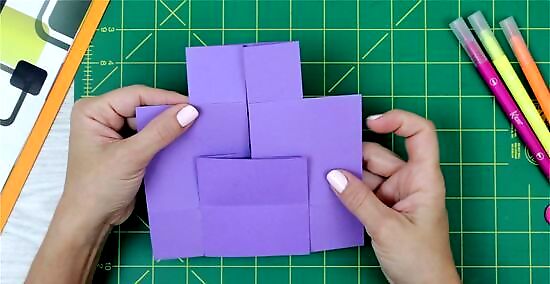
Practice opening the card to each of the 4 views. Once your card base is completely assembled and the fold lines are creased, start testing out the assembly and never-ending unfolding patterns. Try repeating the unfolding sequence a few times to make the card a little easier to operate. You’ll notice that, although it’s called a never-ending card, it actually has 4 different views. Open the 4-piece card by lifting the flaps from the middle and folding them to the back of the card to expose a new layer of cardstock. With a 4-piece card base, the first view is made up of the first 2 pieces of cardstock that you placed side by side to form a large square. The second and third views are also square, and the fourth view is plus-shaped. To open a folded 1-piece card base, instead of opening both left and right flaps to reveal the new view, simply re-fold the card in half, turning both sides away from you. This will allow you to unfold it along a new crease to reveal a new view.
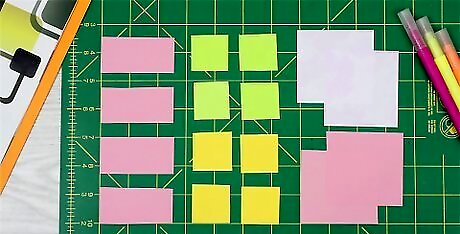
Cut out a series of smaller squares and rectangles from decorative paper. While it can be fun to add decorations directly onto the card base, you can spruce up your card by adding a layer of contrasting paper to the panels in each card view. Choose a different color from the card base, or try a patterned paper for these decorative panels. Feel free to use medium to lightweight cardstock or lightweight scrapbook paper. To create decorative panels for a 4-piece card base, cut 8 squares measuring 2 ⁄4 in (7.0 cm) by 2 ⁄4 in (7.0 cm) each, which will be used to decorate the large square sections on the card. For the smaller side panels, cut out 4 rectangles measuring 2 ⁄4 in (7.0 cm) by 1 ⁄4 in (3.2 cm) and 16 small squares measuring 1 ⁄4 in (3.2 cm) by 1 ⁄4 in (3.2 cm). To make decorative panels for the 1-piece card base, cut out 16 1 ⁄4 in (4.4 cm) by 1 ⁄4 in (4.4 cm) square pieces.
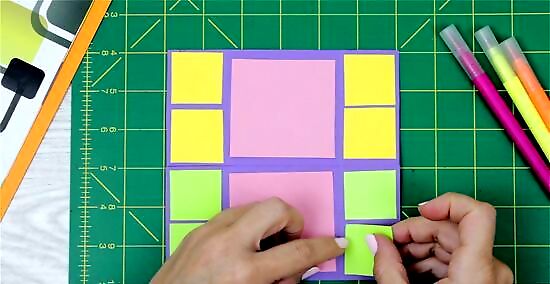
Open the card to each view and glue the decorative paper pieces onto each panel. As you open the card to each view, you’ll be able to see where the large squares, small squares, and rectangles should go. Each piece of decorative paper will sit within your score lines and creases so that the unfolding pattern isn’t obstructed by another layer of paper. While you can use white craft glue, a glue stick or double-sided tape will be quicker. With the 4-piece card base, begin with the first view, which has your first 2 pieces of cardstock sitting side by side. Glue 2 large squares and 4 rectangles onto the middle and outside panels. Then glue 2 large squares and 8 small squares onto the panels you see within the second view. In the third view, glue 2 large squares to the center panels and affix 4 small squares to the corners. When you get to the plus-shaped fourth view, glue on the last 2 large squares and the last 4 small squares. For a 1-piece card base, since all of the square sections are the same size, you can simply glue 4 squares onto each 4 in (10 cm) by 4 in (10 cm) view.
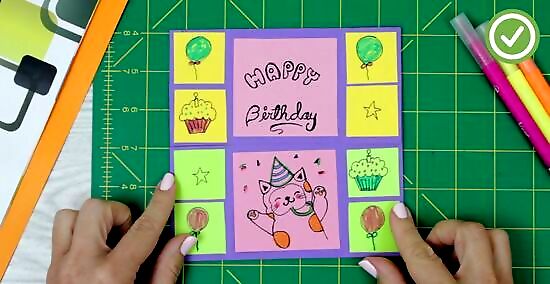
Use craft supplies and your imagination to decorate the panels. With your never-ending card fully constructed and enhanced with decorative paper on each panel, you’re ready to start personalizing and embellishing your card. Add whatever decorations you choose to each of the panels. Feel free to use stickers, die-cuts, photographs, and stamps or create your own illustrations, doodles, and collages. Sign off with a handwritten note, either hidden in one of the views or spread across all 4. It’s fine to have flat decorations, like drawings or stamped designs, go past the fold lines. Just don’t place any layers of paper or raised decorations over the fold lines. For a 1-piece card, it can be fun to add one motif, like a heart cutout, across the whole view. Just make sure you cut the motif into 4 quarters so you can still unfold the card. Keep in mind that with a 4-piece card, the large squares in the fourth view will also be partly visible in the third view. You may want to design your decorations for the top of the upper square and the bottom of the lower square with this in mind.














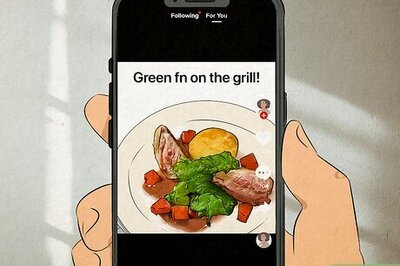
Comments
0 comment